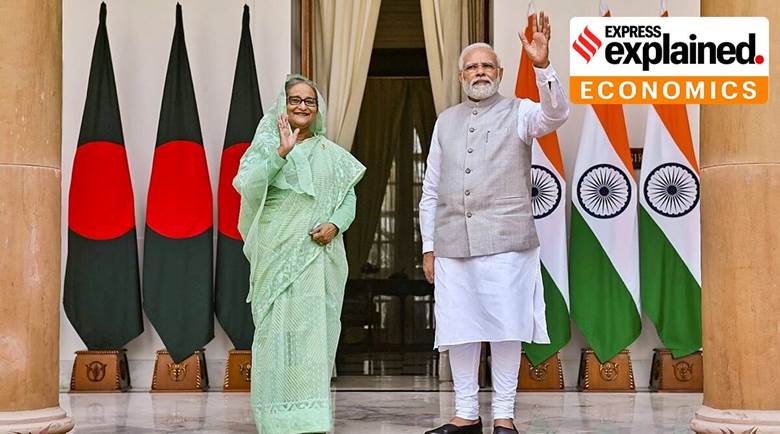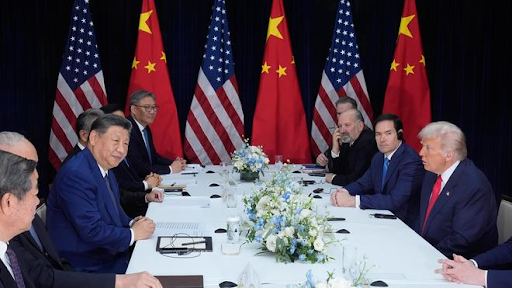Description

Copyright infringement not intended
Context: Following a meeting with the visiting Prime Minister of Bangladesh Sheikh Hasina, Prime Minister Narendra Modi said India and Bangladesh will soon commence negotiations on a Bilateral Comprehensive Economic Partnership Agreement (CEPA). India and Bangladesh should resolve all bilateral issues, including the differences over the waters of the Teesta, “at an early date”, Bangladesh Prime Minister Sheikh Hasina said.
Details:
- After holding bilateral talks with Prime Minister Narendra Modi, the visiting leader described India as the “most important and closest neighbour” that is bound with Bangladesh through 54 common rivers and 4,000 km of border.
- The two sides signed seven agreements covering railways, science and technology, space cooperation, media, and water sharing.
- The two sides, however, made a significant beginning in river-water sharing by reaching an agreement — a first in 28 years — on drawing water from the common border river Kushiyara for supplying to parts of lower Assam as well as Sylhet in Bangladesh.
- PM Modi highlighted the values that made India and Bangladesh to put up a joint fight in the Liberation War of 1971 and said, “In order keep the spirit of 1971 alive, it is necessary that we confront those forces that want to hurt our common values.”
- The pact over the Kushiyara was the first river-related agreement that the two sides reached 28 years after the conclusion of the Ganga Waters Agreement of 1996.
- India had extended the period of sharing flood water-related information in real time that would help Bangladesh counter the annual floods.
- The Ministries of Railways of India and Bangladesh signed an agreement on training of personnel of the Bangladesh Railway in India.
- In a bid to help Bangladesh deal with energy crisis, the two leaders unveiled Unit 1 of the Maitree power plant, a 1,320-MW supercritical coal-fired thermal power plant, at Rampal in Khulna division of Bangladesh.
- The two sides also inaugurated the Rupsha rail bridge, which will help in connecting Khulna with Mongla port and Petrapole and Gede in West Bengal.
- Hasina met with President Droupadi Murmu
- She will hand over Mujib scholarships to 200 family members of the personnel of the Indian military who were killed or wounded during the Liberation War of 1971.
Dhaka’s defence demands:
- Marking some progress on the delayed implementation of the $500 million defence Line of Credit (LoC) extended by India to Bangladesh, Dhaka has recently shared a wish list of military platforms and systems that its armed forces would like to procure from India.
- This includes a diverse range of equipment, including a floating dock, and logistics ship and oil tanker for the Bangladesh Navy, among others.
- India is keen to offer artillery guns, mortars, rockets and missiles, support vehicles, electronic and engineering equipment, radars, helicopters, military rakes, and ship building services.
- In addition, Bangladesh can also be offered India’s expertise in sea and airport infrastructure development among others.
- There is also scope for cooperation in high technology sectors in which India has expertise, and these include Information Technology and cyber space, satellite and space technology, maintenance and overhaul, development of local defence industry, and training
Trade:
- In 2021-22, Bangladesh has emerged as the largest trade partner for India in South Asia and the fourth largest destination for Indian exports worldwide.
- Exports to Bangladesh grew more than 66 per cent from $9.69 billion in FY 2020-21 to $16.15 billion in FY 2021-22.
- India is Bangladesh’s second biggest trade partner, and its largest export market in Asia. Despite Covid-19 related disruptions, bilateral trade grew at an unprecedented rate of almost 44 per cent from $10.78 billion in 2020-21 to $18.13 billion in 2021-22.
- India’s main exports to Bangladesh are raw cotton, non-retail pure cotton yarn, and electricity, and its main imports from the country are pure vegetable oils, non-knit men’s suits, and textile scraps.
- While informal talks on CEPA have been happening since 2018, officials said that the pandemic has brought urgency.
- Chinese investments in Bangladesh were an initial trigger for India, but Delhi and Dhaka want to step up the pace following the economic shock faced by the two economies.
- The CEPA is likely to focus on trade in goods, services, and investment, with a key objective being the reduction of the trade gap between the two countries.
- As Bangladesh prepares to graduate into a developing nation by 2026 — after which it may no longer qualify for trade benefits that it currently enjoys as a least-developed country — it is keen to clinch the CEPA in a year.
- The current institutional frameworks for trade and investment include:
- During the visit of Prime Minister Modi to Bangladesh in June 2015, the bilateral trade agreement between the two countries was renewed for a period of five years with a provision for auto renewal.
- Under the provisions of the South Asian Free Trade Area (SAFTA), Bangladesh extends preferential tariffs to Indian exports of products outside the ‘sensitive list’ of 993 items. In 2011, India announced duty-free, quota-free access to Bangladesh for all tariff lines except tobacco and alcohol.
- An Agreement on Promotion and Protection of Investments has been in force since 2011. Joint Interpretative Notes to the agreement were signed during the visit of the Indian Finance Minister to
- To facilitate trade and transit through inland waterways, a Protocol on Inland Waterways Trade and Transit (PIWTT) has been in place since 1972. The PIWTT too was renewed for a period of five years with a provision for auto renewal during Modi’s visit to Bangladesh in 2015. The protocol allows the movement of goods by barges/ vessels on eight routes between points in India and Bangladesh, as well as between points in India through Bangladesh.
- Direct sea movement of containerized/ bulk/ dry cargo began after the signing of a Memorandum of Understanding (MoU) on Coastal Shipping in June 2015. This has reduced the shipping time between India and Bangladesh from 30-40 days to 7-10 days, and has the potential to emerge as an economical mode of transportation for business communities on both sides.
- MoUs were signed in 2015 on the use of the Chittagong and Mongla Ports for Movement of Goods to and from India.
- The MoU on Border Haats on the India-Bangladesh border was renewed in April 2017 during the visit of Prime Minister Hasina to India. Currently, four Border Haats — two each in Meghalaya (Kalaichar and Balat) and Tripura (Srinagar and Kamalasagar) — are functional. Work on setting up two more haats on the Tripura-Bangladesh border and four on the Meghalaya-Bangladesh border is under way. The two sides have also decided to identify locations for another six Border Haats.

What is the status of the Teesta dispute?
- The 400-odd-km-long Teesta rises in the Pauhunri mountain and flows through Sikkim and West Bengal before entering Bangladesh near Mekliganj, downstream of Jalpaiguri.
- The Teesta, which joins the Brahmaputra in Bangladesh, carries a significant volume of water; it is the second largest river of West Bengal after the Ganga. India and Bangladesh have been in negotiations to determine the share of each country in the waters of the river since the early 1980s.
- The two countries had reached a water-sharing agreement in 2011, and Prime Minister Manmohan Singh was about to sign the deal on what was billed as a historic visit to Bangladesh in September that year.
- However, West Bengal Chief Minister Mamata Banerjee, who was supposed to accompany the Prime Minister, objected at the last moment, pulling out the visit, and the deal was scuttled.
- Prime Minister Narendra Modi visited Dhaka in June 2015. He was accompanied by Mamata, and he told Prime Minister Hasina that he was confident of a “fair solution” to the dispute through cooperation between the central and the state governments.
- Seven years later, the Teesta issue remains unresolved.
How has the relationship with Bangladesh evolved over the years?
- India has a robust relationship with Bangladesh, which it has carefully cultivated especially since Prime Minister Hasina came to power in 2009.
- Over this period, India has benefited greatly from the security relationship with Bangladesh, and the Hasina government’s crackdown against anti-India outfits, which has helped New Delhi maintain peace and security in India’s eastern and Northeastern states.
- Bangladesh too has benefited from its economic and development partnership with India.
- It is India’s biggest trade partner in South Asia, and bilateral trade has grown steadily over the last decade: Bangladesh’s exports to India has gone from only $304.63 million in 2009-10 to $1.28 billion in 2020-21, while its imports from India during this same period have risen from $2.3 billion to $8.6 billion.
- India grants some 15-20 lakh visas every year to Bangladeshi nationals who visit for medical treatment, tourism, work, and entertainment.
- It is fairly common for Bangladeshi elite to make a weekend shopping trip to India.
- For India, Bangladesh has been a key partner in the neighbourhood first policy — and possibly the only success story in bilateral ties among its neighbours.
What are the recent irritants in the bilateral relationship?
- The proposed countrywide National Register of Citizens (NRC) and the Citizenship Amendment Act (CAA) created some rough edges in the relationship. Bangladesh cancelled visits by ministers, and Prime Minister Hasina expressed some reservations about CAA — saying that while the CAA and the proposed nationwide NRC are “internal matters” of India, the CAA move was “not necessary”.
- Subsequently, then Foreign Secretary Harsh Vardhan Shringla, who had been a former Indian envoy to Bangladesh, travelled to Dhaka twice to assuage these concerns.
https://www.pib.gov.in/PressReleasePage.aspx?PRID=1857166







